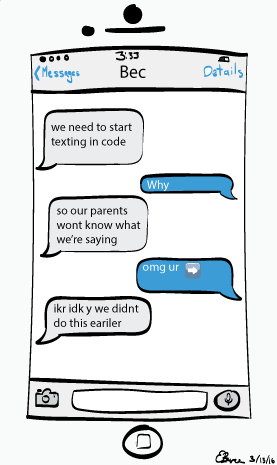Texting lingo goes into mainstream
Messaging slang integrates into everyday speech.
March 16, 2016
Terms such as “bae” and “on fleek” are paving their way into modern day vernacular through Instagram captions, Snapchats and even the dictionary.
“Young people bring new language into the culture,” Lynne Soffer, Professional Dialect, Speech and Text Coach, said. “They speak it around their parents and their aunts and their uncles, and it spreads that way.”
In the “early ages” of cellular devices, flip phones limited the number of characters, the generic text box permitting 160 characters per text, leading users to shorten phrases to acronyms.
Although text messages and social media captions have since expanded in word count, constant condensing of language continues due to Internet and social media, according to Soffer.
“Very often, what happens online is simplified,” Soffer said. “Very few people are writing moving profundities on Twitter and Facebook. It doesn’t seem to be the easy or default way to talk, and as a result, we are artificially inflating and hyping language at the same time we are
reducing it.”
Every culture has always shared abbreviations, but changes in language are further sped up by the Internet.
“Most of the time we are constantly communicating, fast, but not mindfully and superficially,” Soffer said. “This constant communication without actual communication is demeaning, denuding and diminishing what communication can be.”
Forty-five percent of teenagers prefer communicating using a mobile device to face-to-face communication, according to Common Sense Media Research.
Few current high school students have known a life free of cellular devices, making them a generation of cell phone user “natives” as opposed to the “immigrants” that characterize their parents’ generation.
“There’s so many elements that contribute to why we say what we say,” Soffer said. “Some of it is generational, some of it is locational or regional, and some of that is then situational. We are a product of our time and our place.”
Seventy-eight percent of students received their first cellphones between fifth and eighth grade, only five or six years after their parents did, according to a Broadview online survey conducted on March 8.
“It’s something that every teenager has really adapted to over the ages,” junior Chloe Yu said. “New inventions will lead to new words, so when the front camera came about, it just became easier to say ‘selfie’ instead of ‘I took a picture of myself now.’”
The most popular acronyms students use online are “bae,” meaning “before anyone else,” and “omg,” meaning “oh my god,” according to a Broadview survey conducted on Feb. 23 in which 47 percent of students responded.
“This language and form of communication is kind of like our little code,” sophomore Starneisia Hooper said. “Adults aren’t always likely to catch on very quickly.”
Exceptions exist in adults who spend more time with teenagers, according to Soffer.
“I’m really seeing these terms everywhere now,” Hooper said. “My mom will say, ‘Out with my bae,’ and I’m like, ‘No, you have a husband, say that you’re out with your husband.’”
The frequent use of Internet-developed language is extremely popular among teenagers using social media, according to Hooper.
“The more you watch movies, the more you’re online trolling around, the fewer books you read,” Soffer said “The fewer books you read, the less likely your vocabulary is to expand. I think people nowadays use less vocabulary and throw a lot of buzz words back and forth.”
Oxford English Dictionary editors have embraced certain Internet-originated terms by adding words like “selfie” and “vape” to the dictionary and naming them Word of the Year for 2013 and 2014.
“These terms aren’t like traditional dictionary words, but as long as they don’t make their way into business papers or formal things like that, then I think it’s fine,” Yu said. “It’s a little weird that those terms are in the official dictionary, but I don’t really mind it.”










